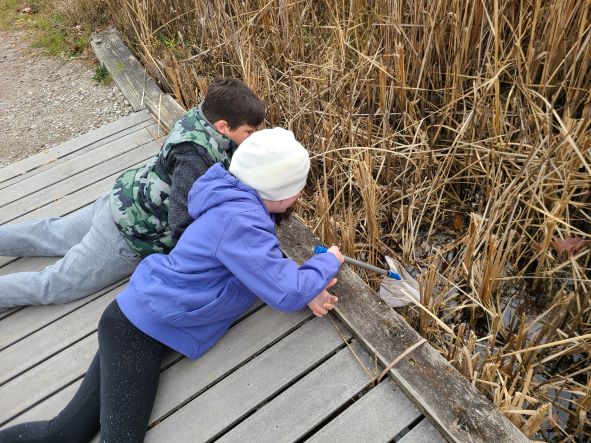By Bodhi Nithyananda, Seasonal Naturalist
 Who would have known there was so much to see beneath the surface of the Deer Haven wetlands on a snowy 28’F November morning! And who would have guessed that every single fifth grader present would be so excited and engaged to stay outside for 50 minutes, dipping their nets into the wetlands, and braving cold hands, to discover the unseen wonders.
Who would have known there was so much to see beneath the surface of the Deer Haven wetlands on a snowy 28’F November morning! And who would have guessed that every single fifth grader present would be so excited and engaged to stay outside for 50 minutes, dipping their nets into the wetlands, and braving cold hands, to discover the unseen wonders.
Having never done a wetland study in the colder temperatures of fall, I was not sure what we would find. As one 5th grader so aptly put it, “This wetland must be really healthy because of everything we have seen!”
The list of aquatic insects and macroinvertebrates was long and the numbers of cold, slow, moving larvae was impressive.
 Those of you that are fans of macroinvertebrates, (macro – can be seen with the naked eye, invertebrate – animals without a backbone) know that we all long to see a Hellgrammite or Dobson fly larvae, but this scary looking macroinvertebrate was elusive all spring and summer, never showing up in a net. On the freezing November day, when there was a sheet of ice on the water, the kids lay on their bellies on the boardwalk, dipped their nets and brought up a Hellgrammite. This grayish black larvae sort of looks like a flattened centipede and has a black head and sharp pincers that you have to watch out for.
Those of you that are fans of macroinvertebrates, (macro – can be seen with the naked eye, invertebrate – animals without a backbone) know that we all long to see a Hellgrammite or Dobson fly larvae, but this scary looking macroinvertebrate was elusive all spring and summer, never showing up in a net. On the freezing November day, when there was a sheet of ice on the water, the kids lay on their bellies on the boardwalk, dipped their nets and brought up a Hellgrammite. This grayish black larvae sort of looks like a flattened centipede and has a black head and sharp pincers that you have to watch out for.
 When a net came up with one of the most fun and aggressive macroinvertebrates, a predacious diving beetle, both the kids and adults were shrieking with awe and a little fear. The size of these predators at 1.5 inches long is quite impressive. When I told the kids they were carnivores, the water beetle gained even more respect, being able to eat fish larger than itself.
When a net came up with one of the most fun and aggressive macroinvertebrates, a predacious diving beetle, both the kids and adults were shrieking with awe and a little fear. The size of these predators at 1.5 inches long is quite impressive. When I told the kids they were carnivores, the water beetle gained even more respect, being able to eat fish larger than itself.
We saw dragonfly and damselfly larvae, which after the initial lesson, the kids understood were not “babies” but were insects in different larval stages on their way to becoming adults. The most abundant aquatic insect seemed to be water boatmen and backswimmers. Even the most tentative student was able to catch these athletic swimmers in their nets.
By far, the biggest trophy of the day were the giant tadpoles, with some kids hauling them up left and right, and others determined to stay out in the freezing wetland until they also could say they caught one!
School field trips are a big part of what we do at Preservation Parks, serving over 1400 participants in the 2021-2022 school year. Contact Casey Smith at outreachprograms@preservationparks.com for more information.
Photos courtesy of Schultz Elementary 5th Grade Team.






